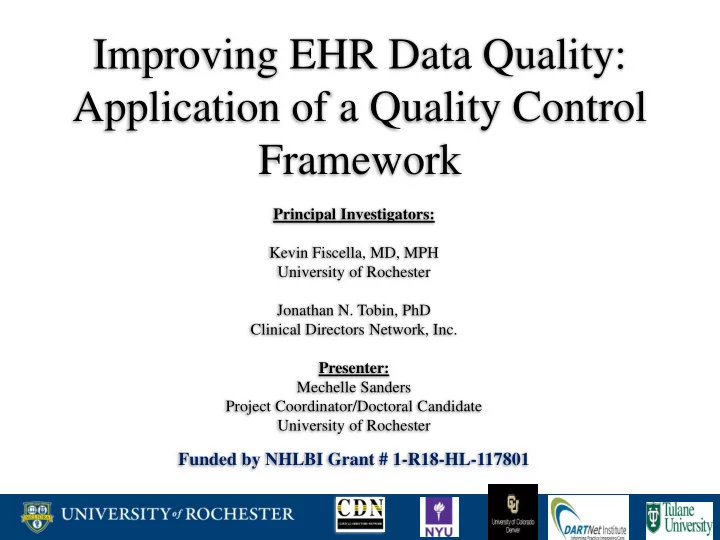

Improving EHR Data Quality: Application of a Quality Control Framework Principal Investigators: Kevin Fiscella, MD, MPH University of Rochester Jonathan N. Tobin, PhD Clinical Directors Network, Inc. Presenter: Mechelle Sanders Project Coordinator/Doctoral Candidate University of Rochester Funded by NHLBI Grant # 1-R18-HL-117801
OBJECTIVE Data quality assessment for the valid use of Electronic Health Records (EHR) data for: research in pragmatic clinical trials quality improvement activities Adopted the Harmonized Data Quality Framework (DQ) Khan et al developed terminology and DQ Framework Funded by the Agency for Healthcare Research and Quality (AHRQ) and the Patient-Centered Outcomes Research Institute (PCORI). We applied the framework in the context of the Blood Pressure Intensification Study
DQ FRAMEWORK 3 Domains of Quality 1. Data Completeness 2. Data Fidelity/Conformance 3. Data Plausibility Composite Score ranging from 0-10 “0” no issues assessed
SAMPLE FRAMEWORK
STUDY POPULATION 10 FQHCs in New York and New Jersey Members of Clinical Directors Network , an AHRQ- designated Center of Excellence (P30) for Practice Based Research and Learning 7 EHR Systems EPIC GE Centricity Success EHS NextGen eClinicalWorks Homegrown Athena Extracting data for roughly 600 hypertensive patient per month per FQHC
Primary data are obtained through extraction of electronic health records (EHR) at each site Clinician Unique identifier for patient Patient demographics (race, ethnicity, language) Insurance Blood pressure(s) (BP) Date of visit ICD 9/10 codes BP medications Lab tests
RESULTS Each of the FQHCs data uploads had at least 1 data deficiency Data Fidelity Non- unique patient id’s Computed BMI vs. EHR reported BMI Data Completeness Missing variables Inconsistent blood pressure (BP) reporting Data Plausibility Negative values for height, weight, BP BP recorded was not in reasonable range Inconsistent ICD-9/10 codes BP rates not in line with those reported to the Health Resource and Services Administration (HRSA)
Corrections That Were Feasible Missing ICD 9/10 codes, but had the description
Corrections That Were NOT Feasible Values were not entered in a structured field
RESULTS Mean Baseline DQ Score = 3.6 Mean Post DQ Score = 0.7 Mean number of corrective actions= 4.2 Refers to the number of corrections the site needed to make before DQ Standards were met Mean number of encounters with the site=5 Refers to number of communications with the site to get the “Final” data set
CONCLUSIONS DQ Tool provides a meaningful framework for identifying, documenting, and addressing data quality issues DQ Tool enhanced EHR data quality for research AND Quality Improvement (QI) efforts
POLICY AND PRACTICE IMPLICATIONS DQ Tool can be used to understand strengths and limitations of EHR data Systematic Method for EHR data assessment Can facilitate the transfer of data for quality reporting initiatives: Meaningful Use Patient-Centered Medical Home HRSA HEDIS
IT TAKES A VILLAGE… Clinical Directors Network (CDN) University of Rochester New York University (NYU) Jonathan N. Tobin, PhD Kevin Fiscella, MD MPH Olugbenga Ogedegbe, MD MPH Andrea Cassells, MPH Mechelle Sanders, BA Stephen Williams, MD Brianna M. D'Orazio, BA Subrina Farah, MS Tulane University Tameir Holder, MPH University of Colorado/NRN AAFP Hua He, PhD Chamanara Khalida, MD MPH Jennifer Carroll, MD MPH DARTNet Institute Cleo Overa, BA Elias Brandt, MS Musarrat Rahman, MPH Participating FQHCs Metropolitan Family Health Brownsville Multiservice Family Health Network ODA Primary Health Care Network Center NYU Lutheran Caribbean Family Health Center Henry J. Austin Health Center Morris Heights Health Center Newark Community Health Joseph P. Addabbo Family Health Center Center CAMcare Health Corporation Community Healthcare Network – Community Healthcare Network Urban Health Plan Queens Health Center
Thank You!
Recommend
More recommend